The ultimate guide to multi-channel prospecting
In this blog
- What is multi-channel prospecting?
- Why should you be using multi-channel outreach?
- Preparing for outreach: Understand your market
- Preparing for a multi-channel approach: Gather your data
- Launching your multi-channel prospecting campaign
- Outbound vs inbound: Why you should be using both
- The benefits of multi-channel prospecting
- Our top tips for better prospecting
- Reach your ideal customers with Sopro’s multi-channel prospecting service

Multi-channel prospecting can make your business more memorable and elevate your outreach. But how do you get started? This guide covers everything you need to know.
From the choppy waters of the economic climate, to changes in rules and regulations, the business world is always evolving. On a human level, behaviours, technologies, and best practices continually develop too.
But the need to rise above your competition remains constant. You need to connect with prospective clients at the right time. You need to sell them the benefits of your offering. And you need to do it better than your competitors.
And right now, the best way to do that is to take your prospecting campaigns multi-channel.
What is multi-channel prospecting?
Multi-channel prospecting is the process of using different channels to reach and engage with prospects. It aims to provide prospects with a consistent message across all channels, leading to more conversions.
Multi-channel outreach should be coordinated across different media to make your message more memorable. Channels can include email, telephone, social media and direct mail.
Follow our ultimate guide to multi-channel prospecting and elevate your business outreach.
Why should you be using multi-channel outreach?
Our State of Prospecting 2025 report surveyed over 400 senior B2B sales and marketing decision-makers.
88% of buyers want to hear from suppliers when they’re researching and evaluating their options. Great news!
And 73% of them want to hear from you via email – way above any other channel.
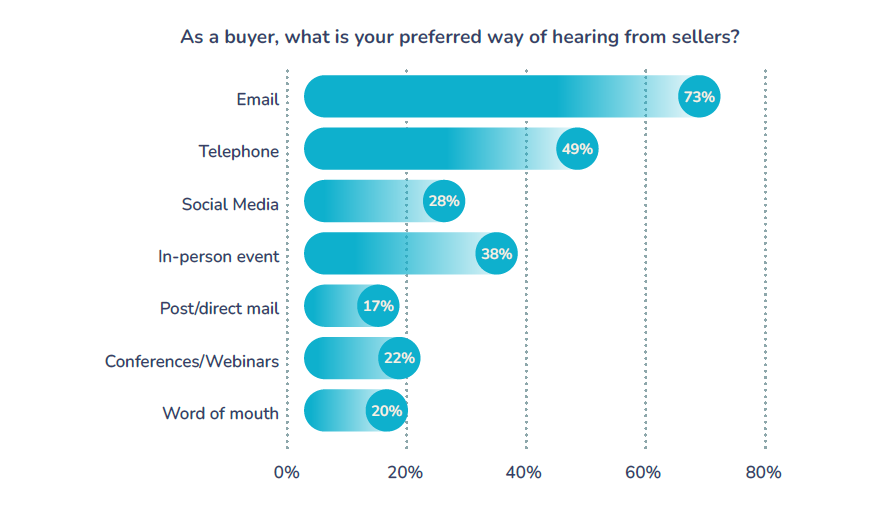
With email being the preferred choice for buyers, it’s no wonder 86% of businesses said email prospecting delivers good to great ROI. So what’s the issue?
Cold email success rates have been dropping, due to a huge increase in competition. New tactics are needed to stand out. But ones rooted in age-old wisdom.
Have you ever heard of the rule of seven?
Dating back to the 1930s, it is a marketing principle stating that a prospective customer needs to come into contact with a brand’s message at least seven times before considering a purchase. The rule highlights the importance of consistent messaging. It cuts through the noise and breeds familiarity and trust.
With falling lead rates for email-only expected to continue, your brand needs to take up more space. So how do you achieve this?
By adopting a multi-channel approach. Level up your email outreach by weaving in additional channels and buyer intent signals. With the latest tech and a greater knowledge of human behaviour in tow, you can take your outreach to new heights.
Preparing for outreach: Understand your market
At its core, multi-channel outreach is people focused. Knowing who the buyer is and what they want is critical. Audience research underpins all your activity. It begins with segmenting your target audience to ensure your messages are hitting the spot.
There’s no fixed way of doing this – you’ll need to find out what works best for your business and, ultimately, the impact on your ROI.
Building your Ideal Customer Profile
An ICP is the perfect company that your organisation solves problems for. The goal of your ICP is to identify the accounts that would gain the maximum value from your product or service, and are most likely to become high-value customers.

How to create a B2B ideal customer profile
Creating an ideal customer profile focuses marketing, increases sales and reduces churn.
Read moreUnderstanding your Buyer Personas
A buyer persona is a fictional profile of the buyers in those companies, based on market and audience research.
Crafting buyer personas is crucial for multi-channel prospecting success. They capture critical personal and business aspects. guiding your understanding of the people that will make the purchase decisions, outlining their buying process, and understanding where they consume media.

How to create B2B buyer personas
Creating B2B buyer personas help to focus your marketing efforts and connect with your prospects.
Read moreUse these insights to connect with your ideal client’s pain points and goals, and map out a strategic content creation plan that resonates across multiple channels.
Leveraging account-based marketing
Account-based marketing identifies and targets high-value business accounts and their stakeholders with tailored marketing efforts.
Sopro research shows there is now an average of four stakeholders involved in the decision-making process (up from 3.6 in 2022). A multi-channel approach enhances visibility across multiple channels, for multiple stakeholders.
This can make you top of mind for more of these key people in these valuable businesses. By integrating ABM into your multi-channel tactics, you’re not just reaching more buyers; you’re ensuring that your message resonates with each one. This fosters recognition and recall among all the relevant people within a company.
Preparing for a multi-channel approach: Gather your data
Once you’ve identified your target market, the next step is to gather the data to contact those people. Equipped with insights into preferences and behaviour, you’re ready to gather their contact information. So, let’s dive into it.
Build your prospecting list
To build a multi-channel prospecting list you need to:
- Comply with all relevant data protection laws
- Target only the right people for your business
- Decide which channels you want to contact them on
- Find and verify their current contact information
There are several ways of doing this, each with their own advantages and disadvantages. Luckily, we’ve written a step-by-step guide to list building.
Make the most of IP matching
IP matching (also know as reverse IP lookup) turns anonymous web traffic into named businesses. At Sopro, we go one step further, adding relevant prospects from relevant companies into clients’ engagement campaigns.
Capturing this hidden interest allows you to uncover brand-new audience segments. And get this, it works! Our client campaigns using IP Match and Engage have increased their booked sales meetings by 15% and the quality of leads by 38%.
Not only this, but IP matching is one part of gathering buyer intent data, which can transform your campaigns.
Dig into buyer intent
Tracking buyer intent helps you deliver a more timely and personal approach. Buyer intent data is the digital footprints users leave as they navigate online. It gives you, the seller, valuable insights into what stage of the sales pipeline buyers is at.
Adapt your messaging depending on the stage: from initial research, to evaluating their different options. It’s not data you can collect immediately, but it can enrich your outreach as your campaign progresses.
Crucially, it means you can contact people at the exact moment they are looking to buy, rather than hoping you catch them at the right time.
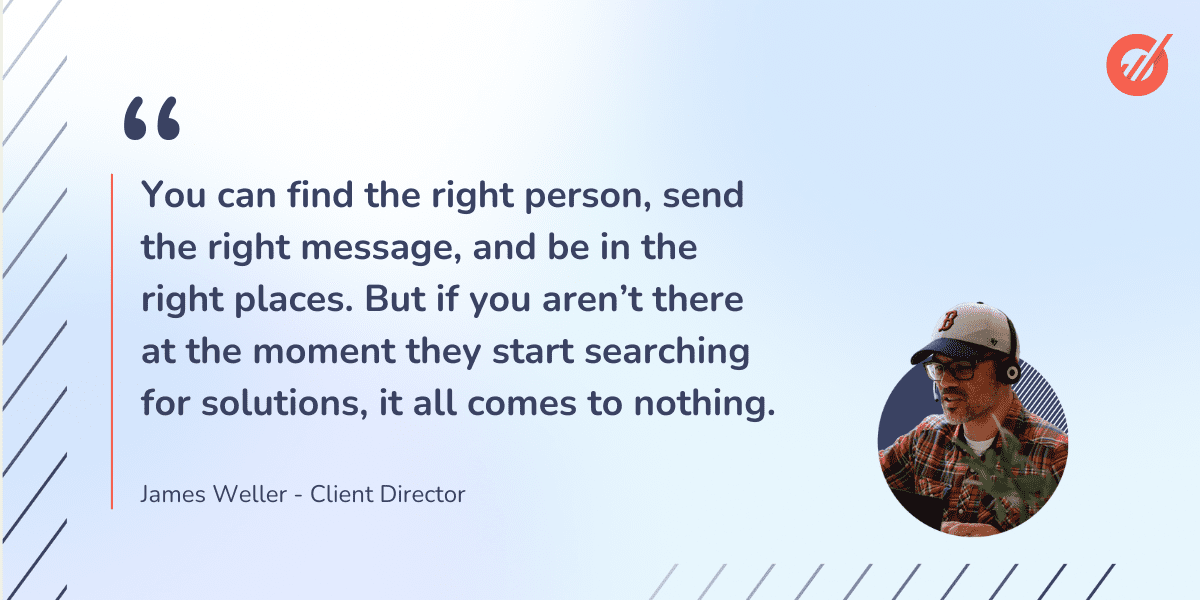
A quick note on compliance
The data needed for multi-channel marketing campaigns demands meticulous adherence to compliance regulations. Complying with these regulations isn’t just a best practice—it’s essential.
Only process the data you need and can prove legitimate interest with. Employ clear privacy policies, conduct regular system audits, and maintain precise records of consent. Promptly honouring opt-out requests is crucial.
If you’re not sure you’re adhering to the relevant laws, it’s always best to seek legal advice. Or work with a company that keeps you safe with their own vast knowledge of all the legal bits *cough cough* – Sopro.
Launching your multi-channel prospecting campaign
A key reason that multi-channel outreach works is it focuses on “the right person, the right message, the right place, and the right time.” We’ve identified what the right person might look like and how to find them, but where do you meet them?
According to our B2B panel of 377 buyers, the multi-channel approach is becoming increasingly established. While many businesses still use email for most of their prospecting, an increase in the number of outreach channels is on the rise.
Cutting above the competition is about making your brand and solution memorable – multi-channel prospecting is the crucial strategy. So, let’s begin to unfold how you can enhance your outreach and resonate with your prospects.
Campaign elements you could be making the most of include:
- Gifting
- Social media
- Paid social
- Direct mail
- SMS/Whatsapp
- Video
- Warm calling
- Cold calling
Making the most of email
Email is the reigning champion of prospecting.
However, this form of outreach is increasing. 347 million emails were sent daily in 2023, with 1.5 million marketing emails opened monthly.
Marketing and sales teams are clueing up, and HubSpot cites that 37% of brands increased their email marketing budget in 2023. But now is not the time to be slowing down on your email prospecting. It’s time to develop your strategy and get creative.
From deliverability to subject lines, there are a lot of factors that combine to strengthen your email outreach strategy.
Deliverability
Check out our checklist below for a quick rundown on all things email deliverability.
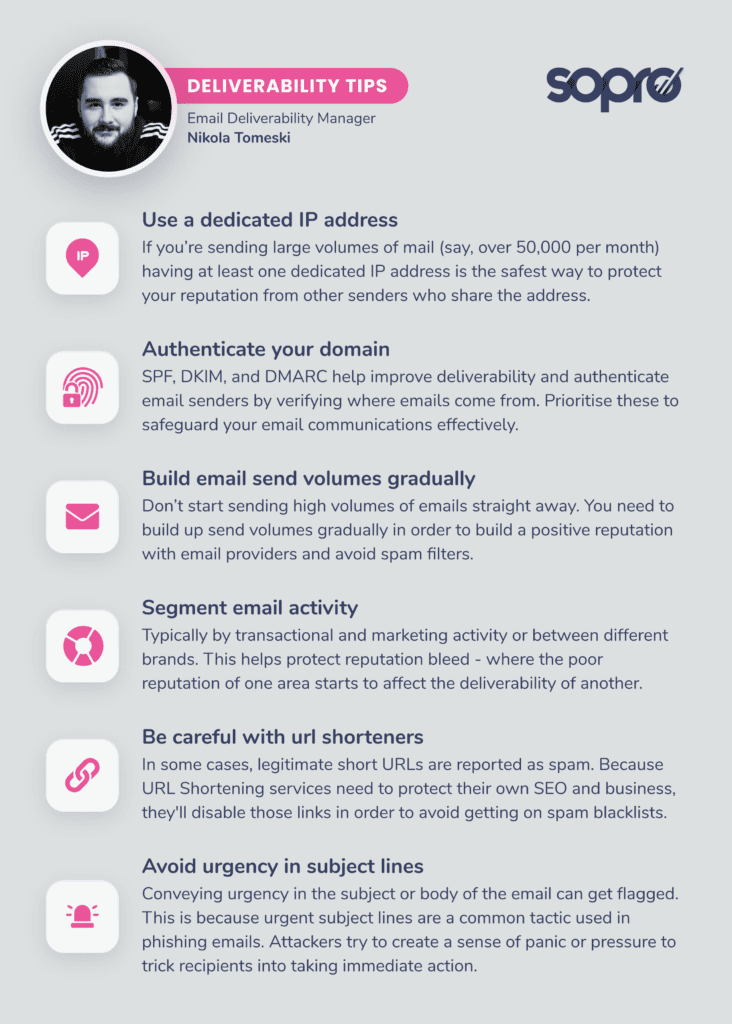
Subject lines
Your subject lines shouldn’t be too long or too short. Our data reveals that between 4 and 7 words is the sweet spot to drive more opens.
But what should they be about? We asked our panel of B2B buyers what would make them more inclined to open an email.
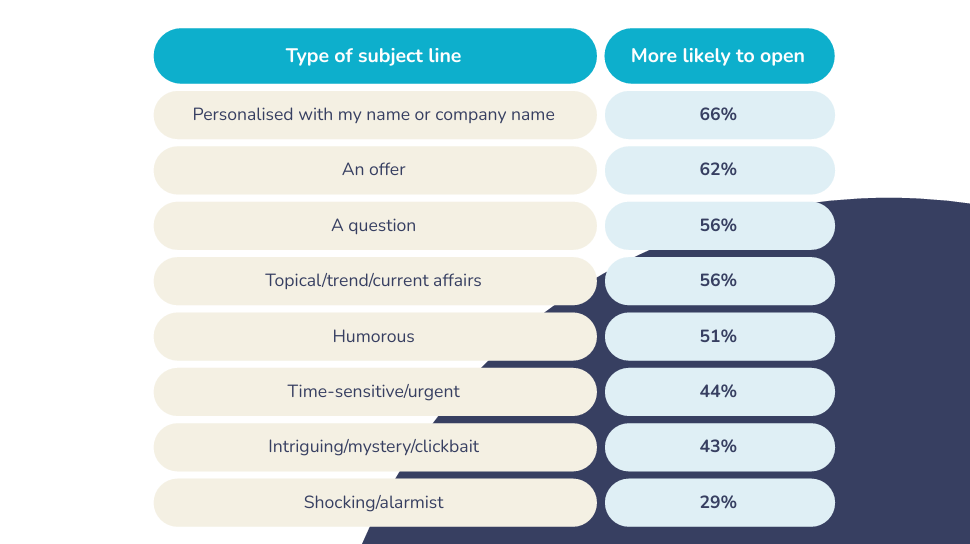
Personalised content is good, clickbait is bad. Who knew?
Email content
To elevate your emails, content must sound natural an strike the right tone.
Our analysis reveals which words and phrases are likely to improve your success rate, and which should be avoided.
Assurance, empathy and social proof all perform well.
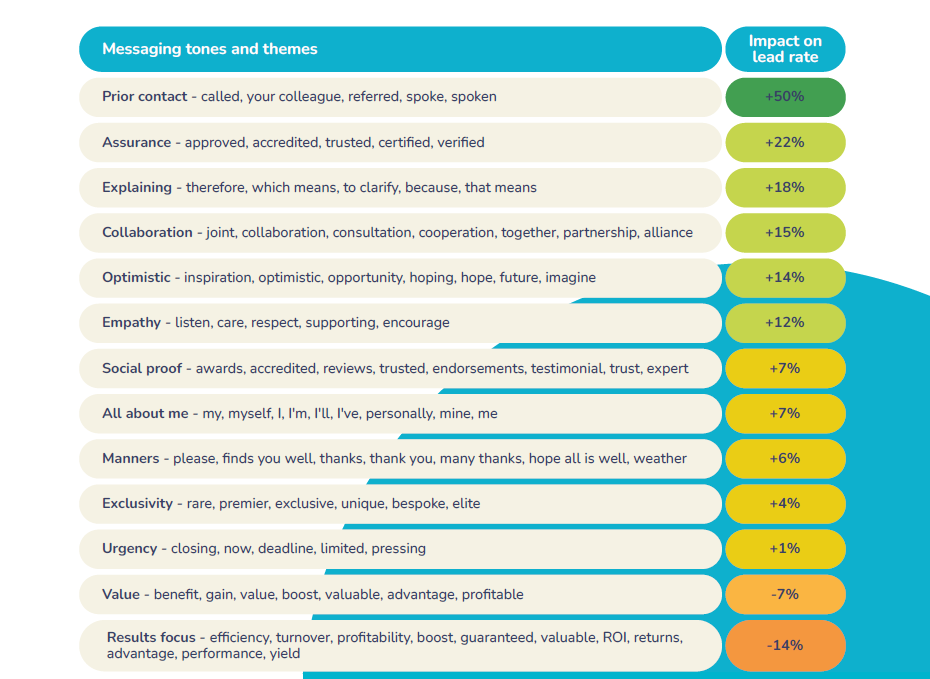
We distilled all our analysis into ten golden rules for great prospecting emails – you can find all of them in 2025’s State of Prospecting report.
Go the extra mile with a gift
We all love receiving a little treat, right? The joy of a gift captivates everyone, so why not add the feeling to your multi-channel outreach to help you stand out from the crowd?
With everything from a cup of coffee to a bottle of champagne, gifting can be a valuable tool in your prospecting efforts. Gifting leverages the reciprocity principle. Prospects are more likely to engage positively, adding perceived value to the interaction and benefitting your brand image.
It’s a great strategy to target those high-value accounts. Looking at Sopro gifting campaigns, we saw 36.1% increase of positive replies wanting a sales call… and the campaigns only saw a gift redemption rate of 0.15%!
Social selling – from LinkedIn to Meta ????️
Social selling has always been a critical player in prospecting, but it can still be elevated.
When bolstered with buyer intent, and used as part of a multi-channel strategy, 55% of Sopro LinkedIn InMail outreach messages progressed into active dialogue. Overall, 4.8% of our intent-based messages saw ended in a meeting booked.
The prior contact and timely contact strengthen outreach, enabling your sales teams to nurture those hot leads.
While it is the king of B2B, LinkedIn isn’t the only social media tool you can be making the most of. Facebook and Instagram can also be indispensable tools for savvy sales reps.
While direct messaging on Facebook may have its limitations, 66% of sales reps harness it for prospecting and business research. With a 51% adoption rate, Instagram also proves a robust avenue for lead discovery.
Integrating both platforms enhances prospecting strategies, helping to ensure audiences are a good fit and unlocking advertising opportunities.
Take up space with paid ads ????
As we’ve seen, a key part of multi-channel marketing is increasing touchpoints across multiple avenues. But paid social advertising can be a little board brush, making spend inefficient.
In collaboration with Clearbit, we’ve tested a ground-breaking feature on our internal campaigns. It enhances B2B targeting on social platforms like Facebook, Instagram, and the Google Display Network. We directly matched our prospecting audience – optimising our ad efficiency.
Despite potential CPM increases, the early results are compelling – a 211% surge in direct leads and a 53% boost in signed deals from highly targeted paid social ads. Beyond measurable outcomes, the feature enhances brand recall among the precise target audience, fostering increased receptiveness to subsequent outreach efforts.
The comeback king – direct mail ????
Potentially the biggest plot twist of the year, Direct Mail has seen an uplift in popularity within B2B sales.
Personalised letters offer a tangible, human touch within the digital sphere. It’s a memorable first impression that adds to that extended personal touch. 18% of companies we surveyed said they were happy to receive something in the post – this has more than doubled from the previous year.
We ran an internal campaign that sent out introductory letters to our audience before reaching out via email. Buyers who received letters were 23% more likely to open that email than those without any prior physical communications.
Let the naysayers know: print isn’t dead.
The power of texting with SMS/WhatsApp ????
SMS and WhatsApp Business can be a key formula to include within your multi-channel prospecting campaigns. It focuses on a highly targeted and impactful form of messaging, yet only 39% of sales teams are making the most of this source of outreach.
SMS generates impressive open rates. According to a report from Mobile Squared, 90% of texts are read within the first three minutes of being sent. It can be an excellent tool for reps to confirm a call, send a helpful resource, or highlight a promotional offer.
However, it’s a complement to other outreach channels. SMS should never be used for a cold approach but rather as a warm follow-up.
Video killed the radio star ????
Did you know? Only 43.8% of sales teams utilise video within their prospecting strategy.
It’s become an original way to stand out from the crowd. Ideally, your video should be no more than 30-60 seconds long, quickly outlining solutions with the prompt for a call at the end.
And it drives results. According to SalesLoft, video prospecting sees a 16% increase in open rates and a 26% increase in responses.
Warm calling ????
Warm calling is a sales method where prospects are contacted after demonstrating an initial interest in your company. It involves reaching out to those who have shown prior engagement, whether downloading content, attending a webinar, or visiting high value pages on your website. This is why tracking buyer intent is such a valuable tool!
Warm calling allows salespeople to have more relevant and personal conversations and allows 31% of salespeople to build more genuine relationships with their customers.
And we can see it working in practice. We examined all client campaigns with more than 100 phone calls logged – 8% of these intent-based warm calls resulted in a booked sales meeting.
Cold calling ❄️
Comparatively, cold calling offers the advantage of a much broader outreach. It allows sales teams to reach a much wider audience – especially when the average cold caller has the ability to make 35-45 phone calls a day.
This tactic also opens up the potential for reaching unexpected opportunities. It allows sales teams to be put in front of people who might not have even been aware of your product or service previously.
Both cold and warm calling have their individual benefits, but depending on the size of your sales teams and their capacity to be able to make hundreds of calls, it’s a good idea to make use of prospecting avenues that maximise the time of your team.
Outbound vs inbound: Why you should be using both
Outbound and inbound make up the two different sides of the marketing coin. Inbound seeks to attract customers by creating divisive and create content, while outbound seeks to reach out to potential buyers directly. And they work really well in tandem.
Inbound marketing involves creating engaging content that pulls prospects to you. Blogs, social media, downloadable content and webinars are used to grow your brand and demonstrate the value you can provide.
However, this also means that the consumer has a direct role in coming in and out of the sales funnel, and it goes without saying, it can be much less personalised.
Outbound marketing – made up of warm and cold calling, email outreach, direct mail and more – is a two-way conversation that starts with a direct approach to relevant prospects.
Outbound allows highly relevant messaging, contacts decision-makers directly, and gives control over where the prospect enters and exits the sales funnel.
Therefore, it is imperative that while your sales teams are working magic with multi-channel prospecting campaigns, your marketing teams are bolstering them with that inbound messaging. This boosts brand awareness and recall, ensuring that your brand is top of mind for all decision-makers involved in the buyer journey.
The benefits of multi-channel prospecting
So, what are the key takeaways here?
Without a doubt, multi-channel prospecting offers an all-encompassing approach to lead generation, leveraging various platforms to enhance outreach and engagement. Exploring the benefits of diverse prospecting strategies enables you to reach out to the right people at the right time and place with the right message.
Here are some headline stats highlighting just how valuable a multi-channel approach is:
- Wider reach
Multi-channel prospecting helps you tap into diverse audiences. It utilises multiple channels, increasing your brand’s visibility and potential leads. - Enhanced targeting
Different platforms cater to distinct demographics. Utilising the multi-channel allows you to target specific audience segments more precisely. - Increased touchpoints
Engaging prospects across various channels ensures multiple touchpoints, reinforcing your message and brand in their minds. - Adaptability
Each channel has its unique strengths. Leveraging multiple platforms enables adaptability in your approach, tailoring strategies to suit the strengths of each channel. - Increased personalisation
Multi-channel prospecting allows for a more personalised approach, tailoring messages and content to suit the preferences and behaviours observed on each platform. This enhances the prospect’s experience, fostering a stronger connection and increasing the likelihood of conversion. - Improved conversion rates
By reaching prospects where they are most active, you enhance the likelihood of conversions. Your message resonates through their preferred channels. - Data insights
Collecting data from multiple channels provides comprehensive insights, aiding in refining strategies and understanding prospect behaviour. - Brand consistency
Maintaining a consistent brand presence across various channels fosters trust and recognition, reinforcing your brand image.
In an increasingly competitive landscape, multi-channel prospecting emerges as a powerful strategy, maximising your outreach and optimising the chances of converting leads into valuable customers.
Our top tips for better prospecting
We’re the prospecting experts (if we do say so ourselves)with eight years of experience. If you’re looking for some savvy tips on executing seamless prospecting, we’ve got a few to hand:
Personalisation
Email personalisation is everywhere, right? That doesn’t mean you shouldn’t use it, but it’s safe to say that *[First name]* and *[Company name]* are no longer enough.
We don’t want you to be shoe-horning in everything you can find out about a prospect from their LinkedIn profile. Still, we know that advanced personalisation is a great place to start, and help to build relationships.
The words you use have also been shown to matter. Content that leverages assurance, empathy, exclusivity, and that personal touch has all been proven to impact qualified lead rates.
Lead scoring
Let’s take it back to the start and build your perfect prospecting list. To target high-quality accounts effectively, it is crucial to determine if a business is a suitable match. By incorporating lead scoring techniques into your sales approach, you can further evaluate the level of intention and capacity to make a purchase.
Two categories of data can be gathered: implicit and explicit scoring. But let’s dig into explicit for now
Explicit scoring is based on information provided by the prospect. This can be categorised using the BANT (Budget, Authority, Needs, and Timeline) methodology.
- Budget: How much can the prospect spend on your solution, and are they willing to outlay this expense?
- Authority: Who are the decision-makers involved in this process?
- Need: Does the prospect have an actual need for the product – will it benefit the team?
- Timeline: How long will it take for the purchasing decision to be made?
Implicit scoring is based on information that you infer about the prospect. Usually from their online behaviour (although offline behaviour can also be used). This can include activities like downloading a whitepaper or revisiting a blog.

What is lead scoring?
Lead scoring helps you focus sales resources where they can make the most impact.
Find out moreIntegrating a CRM
Executing seamless multi-channel prospecting necessitates integrating a Customer Relationship Management (CRM) system for optimal efficiency and effectiveness. A CRM is a must when managing prospect data across diverse channels. It enables a unified and organised approach to outreach. Here’s why it’s essential:
- Unified data management
A CRM consolidates prospect information, ensuring a single, comprehensive view across channels, aiding informed decision-making. - Cross-team coordination
With a CRM, teams can coordinate efforts seamlessly, ensuring consistency in messaging and strategy and avoiding conflicting communications. - Efficient workflow
Streamlining workflows through a CRM ensures smooth collaboration among team members. - Analytics and insights
CRMs provide valuable analytics, offering insights into prospect interactions across channels. This data-driven approach enhances the ability to refine strategies for maximum impact.
A CRM is the linchpin that holds together a successful multi-channel prospecting strategy. It fosters cohesion, personalisation, and data-driven decision-making.
Work with the experts
That would be us ????
With a comprehensive prospecting service, take the stress out of outreach and let us do the heavy lifting.
At Sopro, our multi-channel prospecting approach stands out with various impactful features. Our commitment to enhanced data accuracy ensures that our prospect information is reliable and up-to-date. Crucial for effective engagement across multiple channels.
We understand the value of your time. Our service is tailored to streamline the business development process, saving you valuable time so you can focus on closing leads. But what truly sets us apart is our focus on customised campaigns. We’ll align with your specific business needs and optimise outreach efforts for maximum impact.
Reach your ideal customers with Sopro’s multi-channel prospecting service
In the realm of prospecting, multi-channel outreach is the catalyst for innovation, propelling your strategies to new heights. It’s the future for your effective B2B outreach. Bringing together the latest tech with an elevated understanding of human behaviour.
As the prospecting landscape quickly evolves, the need for creative strategies becomes increasingly evident. It has become integral to push new boundaries and test new technologies to help you reach the right audience at the right time, with the right message, and in the right place. That’s where expanding channel diversity and leveraging AI-driven personalisation can help you stay leagues ahead of the competition.
We’re an award-winning B2B multi-channel marketing agency, redefining traditional outreach and ensuring your brand stands out in the crowded digital sphere.
For deeper insights into the evolving world of prospecting, explore The State of Prospecting 2025. Or book a demo with one of our consultants and embark on a journey towards prospecting excellence.
We’ve delved deep into multi-channel prospecting in this guide, but which sector delivers the most B2B leads from email prospecting? Read our blog to find out.







Share